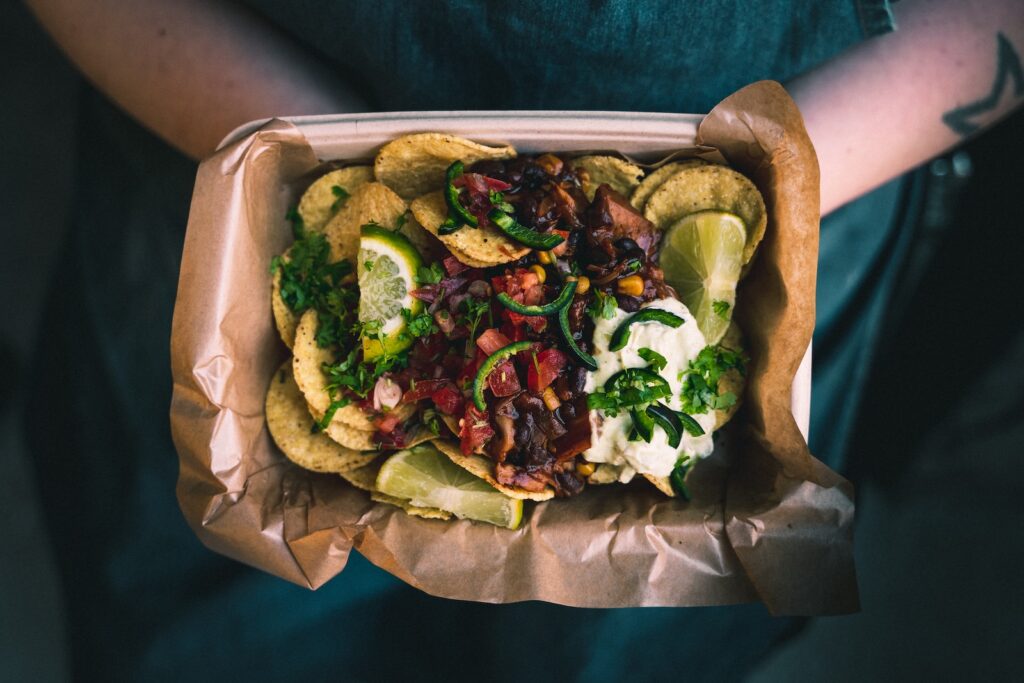Introduction
Welcome to a cornucopia of culinary delights that’s been steadily gaining popularity and making headlines in the food world – street food. What was once considered the fare of the common man, street food has undergone a scrumptious transformation, creating an exciting gastronomic revolution that has bewitched palates around the globe. Through this article, we aim to celebrate the bold flavors, vibrancy, and global impact of this extraordinary culinary movement.
Just as every snowflake is unique, so too is every street food dish. From the bustling roadside stalls of Bangkok serving up mouth-watering Pad Thai to the scorching grills of Mexico City producing tantalizing Tacos Al Pastor, the diverse flavors of street food paint a vivid picture of our world’s culinary landscape.
As you wander through this article, we’ll delve into the rich tapestry of tastes, textures, and aromas that make street food a cultural cornerstone in societies around the world.
The Street Food Revolution

The rise of street food isn’t a simple tale of taste buds tingling; it’s a narrative that encapsulates economic shifts, cultural exchange, and the relentless human spirit. At its core, street food is about the democratization of gourmet experience, where authentic, delicious food isn’t confined to the four walls of upscale restaurants but spills out onto the streets, inviting everyone to partake in a shared feast.
Street food’s allure goes beyond the budget-friendly, delectable eats. It’s the sense of community, the atmospheric hustle and bustle, and the visceral thrill of watching your food being prepared right in front of your eyes. It’s a sensory spectacle, a culinary theatre that unfolds on the sidewalks and corners of our cities.
A Journey of Flavors

As we embark on this journey, we’ll explore the evolution of street food, studying the intricate dance of ingredients and techniques that have shaped this vibrant culinary movement. We’ll dive into the sizzling pans and aromatic spices, inviting you to savor the magic of street food, its past, its present, and its promising future.
So let’s raise a toast to the humble food cart, the sizzling wok, the simmering pot, and the spirited vendors. Here’s to celebrating the rise of street food – a testament to human ingenuity, a tribute to cultural diversity, and an ode to delicious, accessible cuisine that brings us all a little closer, one bite at a time.
A Brief History of Street Food
When we trace the roots of the street food movement, we find ourselves journeying back centuries. The concept of street food has a rich and diverse history, its origins entwined with the fabric of many cultures across the globe. From the bustling food markets of ancient Rome to the noodle vendors of Edo-era Japan, the allure of street food has consistently captivated the masses.
The rise of street food can be attributed to the societal and economic changes of urban growth. As cities expanded, laborers needed quick, affordable food options. Street vendors, with their portable stalls, provided the perfect solution. But street food wasn’t just sustenance; it was a celebration of local flavors and traditions. It gave birth to a unique culinary experience that left no room for pretense, only authenticity.
Over the years, the face of street food has transformed, shaped by the influences of immigration and globalization. Immigrants brought with them their native flavors, blending and adapting recipes to local tastes. Foods once limited to certain geographical locations began to spill over borders, adopting new characteristics while retaining their original essence. This fusion of food cultures gave rise to a culinary diversity that continues to define street food today.
- Migration and Adaptation: When immigrants settled in new lands, they carried their culinary traditions with them. Street food became an expression of heritage, a showcase of a culture’s flavors in a foreign land. This exchange of culinary ideas led to the creation of entirely new dishes, drawing from multiple food cultures.
- Global Influence: As the world became more interconnected, so did its food. The advent of globalization introduced new ingredients and cooking methods to street food vendors, inspiring innovative recipes. This blending of traditions and techniques is a hallmark of the street food scene today.
Today, we see the vibrant reflection of this history in our diverse street food culture. The street food we savor now is a tapestry woven with threads of cultural exchange, innovation, and adaptation. It is a testament to the resilience and creativity of vendors who took simple, local ingredients and elevated them to a culinary art form.
The history of street food is a narrative of our collective culinary journey, a testament to our shared love for good food. It is a chronicle that celebrates the universal language of taste and the power it has to bind us, despite our varied cultures and geographies. So, the next time you bite into a delicious piece of street food, remember, you’re not just savoring a meal, you’re partaking in a rich, global tradition.
The Charm of Street Food

Have you ever walked down a bustling city street, your nostrils teased by the irresistible aroma of sizzling kebabs, or your eyes drawn to the colorful array of fruits and vegetables piled high in a vendor’s cart? If yes, then you’ve experienced the magnetic charm of street food. This culinary phenomenon is more than just a quick and affordable option for a bite, it’s a sensory journey that encapsulates the spirit of a city and its people.
Street food markets are a riot of colors, sounds, and tastes. From the energetic haggling of prices to the theatrical performance of food preparation, everything about these markets is vibrant and lively. In fact, visiting a street food market feels a bit like being absorbed in a live cooking show, where the chefs are the star performers and you, the hungry bystander, are the eager audience.
One of the standout features of street food is its affordability and convenience. In an age where eating out can often be an expensive affair, these markets serve as a budget-friendly alternative. Savory meals and mouth-watering snacks are sold at a fraction of the cost of traditional restaurant food, offering diners the opportunity to taste exquisite flavors without burning a hole in their pockets.
- Street food is not only kind to the wallet but also kind to time. With most dishes prepared on the spot and served quickly, it’s the perfect solution for those with busy schedules and limited lunch breaks.
- In many parts of the world, the convenience of street food is unmatched. From early morning breakfast carts to late-night taco stands, vendors cater to all schedules, ensuring that a delicious meal is just around the corner no matter what time of day.
Street food offers more than just a meal. It offers a shared experience, a chance to gather around a food stall with friends, family, or even strangers, and bond over the universal language of food. It’s a platform for stories, laughter, and community. Street food markets, with their lively atmosphere and communal dining, help to bring people together and foster a sense of belonging.
In today’s world, where human connections can often seem fleeting and superficial, eating street food is a way of participating in a long-standing tradition of community. It’s a way of connecting to the heart of a city, its people, and their culinary history. In essence, the charm of street food lies in its power to turn an ordinary meal into an extraordinary experience.
Street Food vs. Traditional Restaurants

Stepping into the bustling, vibrant world of street food, one can’t help but notice the stark contrast between this raw, authentic culinary scene and the more refined, conventional ambiance of traditional restaurants. This divergence is evident not just in the atmosphere, but also in the dining experience, the challenges faced by vendors, and their innovative spirit.
Dining experience plays a pivotal role in shaping our food choices. When you dine at a traditional restaurant, you’re greeted with a certain level of comfort and convenience – the luxury of sitting in a plush setting, the attentiveness of staff, and a menu that caters to your every whim and fancy. Street food, on the other hand, offers a different, yet equally enticing experience. The thrill of watching your meal prepared in front of you, the aromas wafting through the air, the hustle and bustle of the crowd – these elements create a sensory feast that goes beyond the palate.
- Affordability and convenience are the hallmarks of street food culture. One can savour a hearty, delicious meal without burning a hole in their pocket. There’s no waiting for a table or a lengthy bill settlement – just quick, satisfying grub on the go.
- Street food also offers a diverse range of options, from local delicacies to international flavours, catered to the adventurous gastronome. In contrast, traditional restaurants may tend to limit their menu to specific cuisines or styles.
However, the street food industry is not without its challenges. From licensing hurdles to weather uncertainties and the constant pressure of competition, street food vendors must exhibit resilience and adaptability. Yet, it is in the face of these challenges that their creativity and innovation shine brightest. Whether it’s coming up with unique recipes to stand out or using limited resources to craft culinary masterpieces, street food vendors constantly push the boundaries of what’s possible in a makeshift kitchen.
At the end of the day, it’s not about pitting street food against traditional restaurants. Both have their unique charm and appeal and cater to different moods and preferences. The rise of street food has added another layer to the global culinary landscape, bringing in a fresh, vibrant perspective. So, whether you’re a fan of the relaxed, laid-back vibe of a restaurant or the raw, unfiltered experience of a street food market, there’s no denying that this culinary diversity is something to celebrate.
Global Street Food Trends

Street food, a manifestation of the local culture and culinary identity of a place, has always been a significant part of our food landscape. However, global street food trends are shedding a new light on this longstanding tradition by blending traditional cooking styles with modern cuisine.
The first noteworthy trend is the fusion of traditional and modern cuisine in street food. It’s all about evolution and redefining boundaries while staying true to the roots. A classic example of this is the Korean-Mexican fusion food truck, Kogi BBQ in Los Angeles. This trendsetter combines traditional Korean flavors with the convenience and familiarity of the Tex-Mex taco, creating a unique and exotic taste experience.
- The Fusion of Traditional and Modern Cuisine: Traditional local dishes are being reinvented with a modern twist. For instance, in India, the classic street food “Pani Puri” is now being served with different fillings like guacamole or ceviche, introducing a new flavor profile to the traditional dish.
- Healthy Street Food: With rising health consciousness, a new trend of healthy street food options is emerging. Vendors are now offering dishes made with organic, locally-sourced ingredients, vegan or gluten-free options, showing an increased focus on nutrition without compromising the taste.
- Food Trucks: Food trucks have grown in popularity worldwide, offering gourmet dishes on the go. These mobile kitchens serve everything from barbecued meats to sushi rolls, thereby elevating the street food scene to a whole new level.
Besides the changes in cooking styles and offerings, the influence of social media on the popularity of street food is undeniable. Instagrammable meals served in open-air markets or food trucks have become a staple of lifestyle blogging and have dramatically impacted the food industry. Food enthusiasts around the world are sharing their experiences and discoveries, encouraging others to venture out and try these culinary treasures.
- Social Media Influence: Platforms like Instagram, Facebook, and TikTok are playing a crucial role in promoting street food. Beautifully captured photos and videos of mouth-watering dishes are driving foodies to explore new food stalls and trucks.
- Food Festivals: Food festivals celebrating street food culture are trending globally. These events not only provide a platform for vendors to showcase their culinary skills but also for food lovers to learn about different cuisines and dishes.
Street food trends are not just a fleeting fad; they are a reflection of our evolving food culture. This gastronomic journey from the streets of the world to your plate promises an adventure of flavors worth exploring. Whether it’s a fusion dish, a healthy snack, or a viral food trend, street food continues to surprise and delight us, reminding us of the joy of food in its most honest and accessible form.
Street Food and Sustainability
One of the most fascinating, yet often overlooked aspects of the street food phenomenon is its potential to foster sustainability. Not only does it bring delicious, diverse cuisine to our streets, but it also carries the ability to support local economies, reduce food waste, and promote the use of seasonal ingredients.
Street food vendors have long been champions of local produce. They source their ingredients from farmers and suppliers nearby, thus keeping the food miles down and supporting the local economy. This is a stark contrast to large-scale restaurant chains and supermarkets that often import goods from all over the world.
- Local and Seasonal Ingredients: Street food vendors often rely on the seasonal availability of ingredients, which not only ensures the freshness of the food but also reduces the environmental impact associated with transporting non-seasonal produce. This practice also tends to result in dishes that are vibrant, flavorful and representative of the region’s culinary identity.
- Reduced Food Waste: Another sustainability practice observed among street food vendors is their ability to curtail food waste. They are often adept at estimating the required quantity of ingredients needed for their daily sales, minimizing waste incurred from unsold food. Furthermore, the small-scale nature of these stalls often means that leftover food is minimal.
- Economic Sustainability: Street food vendors also contribute to economic sustainability by providing affordable food options to the community and creating job opportunities. They play a significant role in supporting the food supply chain at a local level, from farmers to consumers, contributing to the economic growth of the community.
While the concept of sustainability in relation to street food might seem like an emerging trend, it has been a part of this culinary culture for a long time. This down-to-earth approach to food preparation and selling is a testament to the resilience and creativity of street food vendors. They work with what is available, make the most of what they have, and create amazing food that is loved by millions.
The commitment of street food vendors to sustainability isn’t just good for the planet, it’s also good for us, the consumers. It means we get to enjoy fresh, locally-sourced, and affordable food, all while supporting our local community.
So the next time we’re tempted to dismiss street food as ‘fast food’, let’s remember the incredible social, economic, and environmental benefits that this culinary movement brings. And let’s make a conscious choice to support the street food vendors who are doing their part to make our world a little greener, one delicious bite at a time.
Celebrating Street Food Culture

As we take this tantalizing journey around the world, it becomes clear that street food culture is not just about feeding our appetites. It’s a global celebration of our rich cultural diversity, shared experiences, and the joy of discovery. It’s an integral part of our social fabric, fostering community spirit, and stimulating local economies. So, how exactly are we celebrating this fascinating culinary movement?
Firstly, we find a plethora of street food festivals and events taking place across the globe. These gatherings are like massive open-air feasts where you can enjoy a smorgasbord of delectable delights, often accompanied by live music, art installations, and vibrant street performances.
- The World Street Food Congress held in Manila aims to create awareness and appreciation for the art of street food.
- London’s Street Feast transforms derelict spaces into unique eating experiences, featuring a rotating line-up of vendors.
- New York’s Smorgasburg, the largest weekly open-air food market in America, showcases 100+ local vendors.
These events are not just about tasting different cuisines. They are a testament to the role of street food in promoting cultural diversity and appreciation. Each stall, each vendor, has a story to tell. From family recipes passed down through generations to innovative culinary experiments, street food is a reflection of our evolving cultural narratives.
From an economic standpoint, the economic benefits of street food on local communities cannot be overstated. The low entry costs allow budding entrepreneurs to set up their businesses and contribute to the local economy. In developing countries, street food vendors provide an essential source of income for millions of people.
It’s also worth noting that many street food vendors are champions of sustainability. They minimize waste by using every part of their ingredients, source products locally, and serve food in biodegradable containers. This embrace of sustainable practices further strengthens the case for supporting and celebrating street food culture.
In essence, to celebrate street food is to celebrate diversity, community, and sustainability. So, the next time you bite into a steaming dumpling from a street vendor or savouring a tantalizing taco at a food festival, remember that you are part of a global culinary movement that is as vibrant and diverse as the flavors on your plate.
Let’s raise a toast to the humble street food vendors, the unsung heroes who feed our souls and connect us to our roots, one delicious bite at a time. As the famous chef and street food aficionado, Anthony Bourdain, once said, “Street food, I believe, is the salvation of the human race“.
Conclusion
In the vibrant tapestry of global cuisine, street food has emerged as a bold and compelling thread, weaving a narrative of culinary innovation, cultural preservation, and community building. In this article, we have embarked on a fascinating gastronomic journey, celebrating the remarkable rise of street food. But this is not just about the food; it’s about the people, the stories and the communities that shape and are shaped by these unique culinary expressions.
From the narrow lanes of Bangkok to the bustling markets of Mexico City, street food has proven itself to be a dynamic and resilient force in the culinary world. It’s not just a trend; it’s a testament to the adaptability and creativity of street vendors who, against numerous challenges, continue to tantalize our taste buds and enrich our dining experiences.
The rise of street food is a reflection of our increasingly interconnected world, a world where a dish from a distant corner can win hearts and satiate our appetite for innovation and diversity. The internet and social media have played a significant role in making street food a global phenomenon, enabling people from different cultures to share their love for food and learn from each other.
Street food is more than just an affordable and convenient food option; it’s a catalyst for fostering connections and bridging cultural divides. The sharing of food, stories, and experiences in these bustling markets encapsulates the essence of human connection. Street food markets have become spaces for celebrating diversity, breaking bread together, and embracing our shared humanity.
Moreover, street food has the potential to contribute significantly to sustainability. With the emphasis on local and seasonal ingredients, it promotes sustainable food practices and can play a crucial role in reducing food waste. In an age where sustainability is more critical than ever, supporting street food can be a step towards creating a more sustainable food system.
On a larger scale, street food has economic benefits, offering employment opportunities and stimulating local economies. It also plays a significant role in promoting tourism, with street food festivals and events becoming significant attractions for food enthusiasts around the world.
As we continue to navigate through a rapidly changing world, one thing remains constant: Our love for food and the experiences it offers. So, let’s continue to support and celebrate street food culture, the unsung hero of the culinary world. As the late Anthony Bourdain once said, “You learn a lot about someone when you share a meal together.” So, let’s continue to learn, share, and grow, one street food dish at a time.

